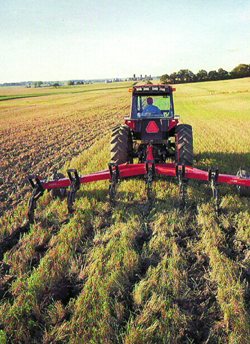Soil Management Guide
Soil Compaction
- Background
- Consult the soils report to assess compaction
- Conduct a site visit to assess compaction
- Recommendations to prevent and correct soil compaction
- Follow-up monitoring
Background
| Soil compaction is the squeezing of together of soil particles, reducing the space available for air and water. Compaction increases the density of the soil, which hampers infiltration of water, soil air movement, seedling emergence, root growth and ultimately reducing yield. Soil aeration is likely to become limiting to plant growth when air-filled porosity in the soil falls below 10%. There are two types of soil compaction: natural and human-induced. In Manitoba, naturally compacted soils contain extremely high levels of carbonates (>40%) or high levels of sodium, with bulk densities greater than 1.8 g/cm3 (these are the soils designated with a D limitation in their agriculture capability rating). Human-induced soil compaction is usually caused in two ways: by excessive tillage and untimely field operations on wet soils (tillage induced), or by wheel tracking in intensive cropping systems (traffic induced). Under favourable conditions, winter freezing and thawing of the soil can correct human-induced compaction problems up to a depth of 2 to 3 feet (60 to 90 centimetres). |  Figure 9.1 Evidence of compaction from equipment traffic |
Most compaction caused by wheel traffic occurs to a depth of 1 to 3 feet (30 to 90 centimetres) on the first pass over a field. The first pass accounts for up to 80% of the compaction that four passes would cause on the same spot.
Soils most susceptible to compaction:
|
 Figure 9.2 Ruts caused by field traffic
|
Moderate surface compaction sometimes increases yield on lighter textured soils with limiting water holding capacity under dry conditions (less than 12 inches or 300 millimetres of rainfall). The opposite is true of clay soils under wet conditions (more than 16 inches or 400 milllimetres of rainfall).
Consult the soils report to assess compaction
- Check soil texture - compaction is influenced by soil texture and moisture status. Compaction is often more difficult to manage on heavier textured soils.
- Check agriculture capability - soils with a D limitation indicate existing compaction, high density or structure problems.
- In addition to the soils report, check recent aerial photos for wheel track patterns.
Conduct a site visit to asses compaction
- The following weeds may be indicators of compaction: silverweed, tansy, plantains, pineappleweed, camomiles, horsenettle, morning-glory, field bindweed, field mustard, stinkweed and quackgrass.
- Identify and confirm compaction problems with a soil penetrometer, shovel and inspection of plant roots.
- Impacts of limited plant root growth can be identified as roots begin to grow horizontal instead of vertical; limited root growth can be the result of poor water infiltration, poor aeration, presence of a hardpan, etc.
- For an accurate measure of compaction, collect bulk density cores (pp. 363-367, in Methods of Soil Analysis, Part 1 (2nd edition)) from the area in question and compare to “normal” areas of the field. Some typical bulk densities for various soil textures are found in Table 9.1.
- Bulk density (BD) calculation: BD = wt of oven-dry soil (g)/volume of soil core (cm3)
Table 9.1 Typical bulk densities for various soil series
| Soil series | Bulk Density (g/cm3) 0-6" depth (0-15 cm) |
| Stockton fine sand | 1.34 |
| Newdale clay loam | 1.26 |
| Red River heavy clay | 1.07 |
| Most rocks | 2.65 |
| Compacted soil | 1.80 |
Recommendations to prevent and correct soil compaction
Healthy plants will be better able to compensate for the stress caused by soil compaction.
Prevention:
- Do not overballast a tractor.
- Run tires at rated pressures (7 to 10 psi (48 to 69 kPa) for radials; no less than 14 psi (97 kPa) for bias ply tires); do not exceed recommended loads for tires; wheel slippage under load should be 10 to 15% for 2-wheel-drive tractors and 8 to 12% for 4-wheel-drive tractors.
- Use duals, triples or larger tires to lower tire pressure - overall, properly inflated radial tires give the best overall performance and value in terms of traction, flotation, efficiency and costs.
- Wheel tractors cause more soil compaction than track-type tractors when tire pressure is high (24 psi or 166 kPa) but wheels cause less soil compaction than tracks when tire pressure is low (7 psi or 48 kPa)
- Soil packing pressure on seeding equipment should be kept to a minimum (approximately 75 pounds (34 kilograms) per wheel) for optimum crop establishment under direct seeding systems. Packing improves stand establishment under dry conditions, but may impede crop emergence under wet conditions. However, this does not necessarily translate into yield differences that are significant to producers (PAMI, Research Update #749).
Correction:There are two extremely different approaches to dealing with soil compaction:
|
 Figure 9.3 A subsoiler/deep ripper |
Follow-up monitoring
- Keep records of tillage operations, such as number of passes, depth, and direction. View aerial photos to see any track patterns in the field.
- Keep records of precipitation and soil moisture content.
- Examine crop rooting patterns.
- Keep records of crop yields.
References:
- PAMI, Research Update #749
- Methods of Soil Analysis, Part 1 (2nd edition)
- Organic Gardening Staff, 1978
- PAMI report #726
- PAMI report #742
- Hofman, 2001
